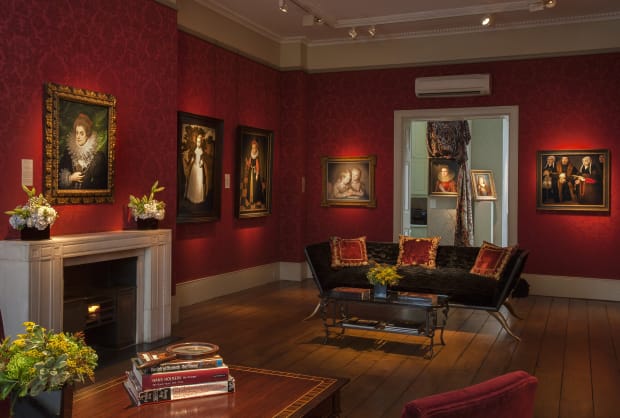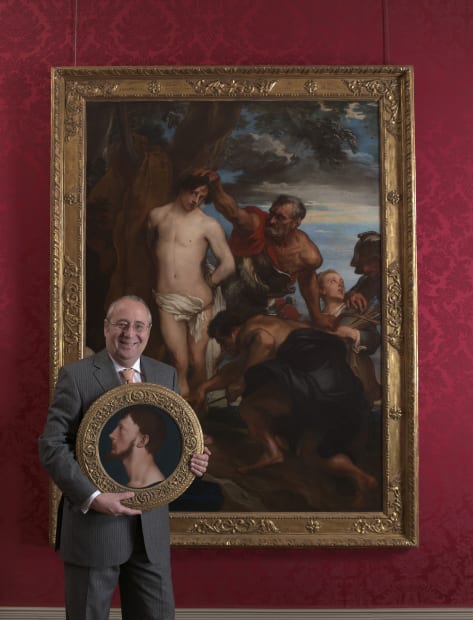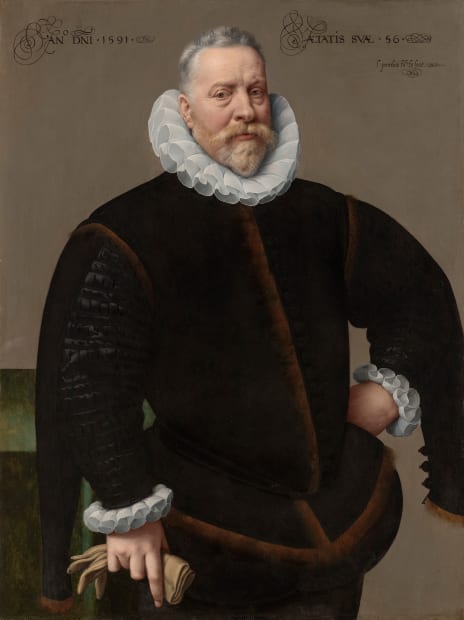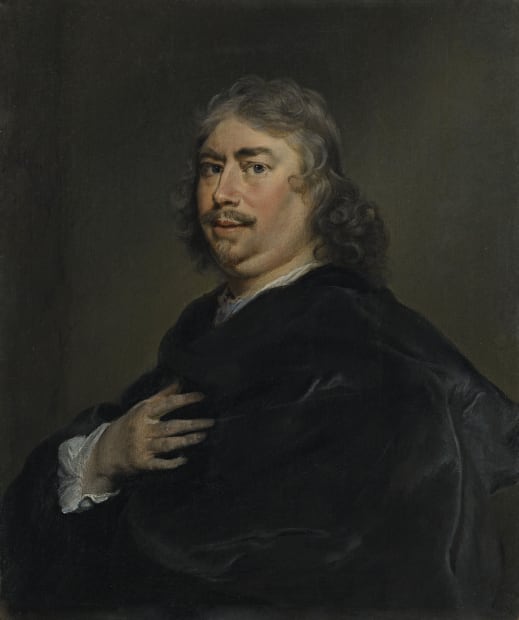-
WELCOME TO THE WEISS GALLERY
See what awaits you at 59 Jermyn Street -

-

-

-

-
My first major client as Bruce Toll, who lived in Philadelphia and made his fortune as the largest builder of executive homes in America. His initial purchase in 1987 was one of my early important discoveries, a hitherto undocumented child portrait by William Larkin that I had bought from Christie's in New York as 'English School'. This beautiful image subsequently graced the front cover of Roy Strong's monograph on the artist published by Franco Maria Ricci in 1993. Over the next few years Bruce went on to buy a number of my most important pictures, including works by Cornelius Johnson and Robert Peake, as well as a remarkable late Elizabethan three-quarter-length of Mary Fitton.
The first five years, as perhaps to be expected, were not easy. Apart from the pressure of endeavouring to build up the business in the very new for me and highly competitive London art market, I was answerable to my outside co-directors and shareholders for its success, or more worryingly, the occasional lack of it. I have always been a very independent person and the pressure of working within the confines of a corporate business eventually came to a head over what proved to be a seminal acquisition.
-

-
It is also the period when I met my next significant client, Frederick W. Hughes - and what an extraordinary, unforgettable man he was. In truth, I found him rather intimidating; he had a witheringly quick wit, a brilliant mind and profound knowledge of English history and its nobility, allied to a very acerbic sense of humour that sometimes verged on cruel. An arch socialite, Fred had been Andy Warhol's business partner and upon Warhol's death in 1987, he became the sole executor of his vast artistic estate from which he created the immensely powerful Andy Warhol Foundation for the Visual Arts. Like Warhol, Fred was a compulsive collector and his ivy-covered town house on the Upper East Side of Manhattan, which he called 'Hotel Anglomania', was stuffed to the gills with the most extraordinarily eclectic objects: Russian Empire vying with early American furniture; a collection of bat skeletons mixed with Native American art and early Mickey Mouse models; my early portraits hung with Orientalist works, and, of course, the obligatory Warhols. Sadly, by the time I came to know him well, he was increasingly crippled by multiple sclerosis, the disease which was ultimately to kill him. However, in a buying spree that only lasted a few years, Fred acquired some wonderful paintings from me including a masterpiece by John Michael Wright, and a highly important portrait of James V of Scotland by Corneille de Lyon.
Some of my most memorable experiences I had with Fred included the last time he visited London in 1991 when he decorated his suite at the Ritz with five paintings that he had 'borrowed' from my gallery. On the day of his departure, I went to collect them to be waved away with an imperious gesture and a curtly barked comment not to touch his paintings - and thus he bought them on the spot! The following year, on a trip to Paris, staying at Le Meurice, he invited me to join him for breakfast in his suite. I arrived to witness that Fred had literally ordered everything on the breakfast menu, delivered by a phalanx of waiters pushing trolly after trolly in to the room... and, whilst I ate like a king, he barely touched a thing. Such extravagance would strain any wallet, and to his assistant's dismay, American Express stopped his card, and I had to assist in settling the bill. By 1993, Fred's illness was such that he ceased to be an active buyer, and indeed in the years leading up to his death in 2001, and in the subsequent estate sale, I bought back the majority of these works and sold them on to other collections.
Around this time, I also became good friends with Jim Welu, Director of the Worcester Art Museum in Massachussets, and within a short period he had acquired two remarkable works. The first was a rare Elizabethan three-quarter-length of John Franham by Steven Cornelisz. van Herwijck, and the second was an intimate small-scale portrait by Frans Hals of his friend, the painter Frans Post.
1995 was a significant year as it saw the opening of 'Dynasties', the Tate's first exhibition dedicated to early British painting for over twenty-five years. The last, in 1969, had been Roy Strong's hugely acclaimed show, 'The Elizabethan Image'. In 1991, I had been approached by Nick Serota, the Tate's Director, to ask if I could help raise some funds to assist in financing a new curatorial position dedicated to Tudor and Jacobean painting, and the curator's first task was to prepare and curate this new exhibition. I made a small personal donation, and managed to persuade Fred Hughes, through the Warhol Foundation, to give a substantial one. All of which helped fund the appointment of Karen Hearn, who became the curator of sixteenth and seventeenth century painting.
It was only natural that I should want to put on my own exhibition to coincide with the opening of Tate's, and Roy very kindly agreed to assist with my show. Looking back on it now, I am quite proud of the impressive selection of portraits that I gathered together which were part loan, and part for sale. Included were important royal portraits of Henry VIII (sold to The Peter Moores Foundation), Edward VI, Elizabeth I (loaned from Hever Castle), Anne of Denmark (sold to the National Maritime Museum), and ELizabeth of Bohemia, as well as James V and James VI of Scotland (sold to Historic Scotland). The most noteworthy painting was a magnificent late Van Dyck of Pompone de Bellievre, who had been the French Ambassador to London.
-

-

-
With my business growing ever more successful, it became clear that the gallery in Albermarle Street was too cramped. Though it had served me well for nearly twenty years, it was now time to look for larger premises, and again, as so often has happened in my life, a confluence of events conspired to assist me. First was the lucky purchase in 2002 of an unrecognised masterpice in Sotheby's first Old Master auction to be held in Paris. Mistakenly catalogued as a copy, and missed by all, I bought for £40,000 a full-length portrait of Louis XIII by Frans Pourbus the Younger. The painting, which was clearly signed and dated, was in virtually pristine condition and on an unlined canvas. What nobody, including the then curator of the Louvre, had failed to notice, was that the so-called original, which was in the Pitti Palace in Florence, clearly depicted the sitter at a slightly older age, even leaving aside the obvious subtle changes in the design. Research subsequently proved that my painting was the original, likely commissioned as a marriage portrait to be sent to Spain, and that the Pitti portrait was a later, second version. The painting sold quickly in 2003 to the Cleveland Art Museum for £650,000.
This sale coincided with the opportunity to acquire 59 Jermyn Street, one of the greatest and most prestigious gallery spaces in London. Formerly the home for some forty years of the renowned Old Master dealership, the Heim Gallery, it had been occupied for the last ten years by the eminent sculpture dealer Danny Katz. Deciding that he wanted to move to Old Bond Street, Danny approached me thinking I was the best person to take it over. In truth, though I was flattered, I was somewhat intimidated at the prospect of taking on a gallery with such a quantum increase in scale. However, instilled with the confidence of the Cleveland sale, I was excited at the prospect and eventually, after a somewhat fraught negotiation, we successfully closed a deal. With the contracts signed, I could not believe my good fortune. This was followed by yet more good news, when we received an invitation to exhibit the following year at TEFAF in Maastricht, the greatest art fair in the world. We have been successfully exhibiting there ever since, putting on what is widely regarded as one of the most dramatic displays in the Old Master section.
In recent years, due to the ever diminishing supply of good examples of Elizabethan and Jacobean portraits, I have taken an increasing interest in French, and in particular, Flemish portraiture, and I'm proud to have handled some undoubted masterpieces such as Jean Clouet's portrait of Francois I's daughter, Madeleine of France, and the highly significant sale of Sir Anthony van Dyck's 'The Martyrdom of Saint Sebastian', which was purchased by the Spanish government and restituted to its former home in the royal collection at the palace of the Escorial. -
"The Howard Ladies"
-
In 2011, I had the unrepeatable opportunity to acquire the majority of the most important early British portraits from the contents of the sale of Cowdray Park held by Christie's, combined with portraits that were sold by Sotheby's as part of the last remnants of the Earls of Elgin and the Marquesses of Ailesbury's great collection at their ancient Savernake estate in Wiltshire. With the spectacular full-length portraits of the 'Howard Ladies', including Peake's masterpiece of Catherine Carey, Countess of Nottingham, and the opportunity to handle the famous full-length Ditchley portrait of Henry VIII, from the collection of Sir Henry Lee (1533 - 1611), the ensuing Tudor and Stuart exhibition I put on in my gallery and on our stand at TEFAF in 2012, was a magnificent moment.
-

-










